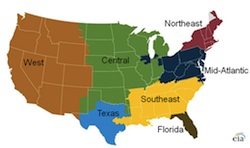According to the most recent Today in Energy published by the U.S. Energy Information Administration (EIA), the mix of fuels used to generate the electricity in homes, factories and businesses across the U.S. has changed over the past few years. While coal remains in the lead, with all the grassroots efforts around ending coal use and as a result the decommissioning of coal plants across the country, the fossil fuel has lost share to other players including natural gas and non-hydroelectric renewables such as wind and solar.
 The report show that the generation mix is not uniform across the country and varies significantly by region (EIA has divided the country into seven regions) depending on available resources and regional market prices. There are several factors that affect fuel mix in any given month including the region’s capacity, the delivered costs of fuels and system constraints.
The report show that the generation mix is not uniform across the country and varies significantly by region (EIA has divided the country into seven regions) depending on available resources and regional market prices. There are several factors that affect fuel mix in any given month including the region’s capacity, the delivered costs of fuels and system constraints.
Natural gas has gained market share from coal in much of the country, find the report, but this is less true in markets closer to the cheaper Powder River Basin coal in the West. Renewable sources are generally growing, especially in Texas and the West. Petroleum-fired electricity generation has been declining for several decades, but it can continue play an important role at rare times when other alternatives are not available.
EIA is planning on publishing a series of articles focused on each region and its electricity generation mix over the coming weeks.

